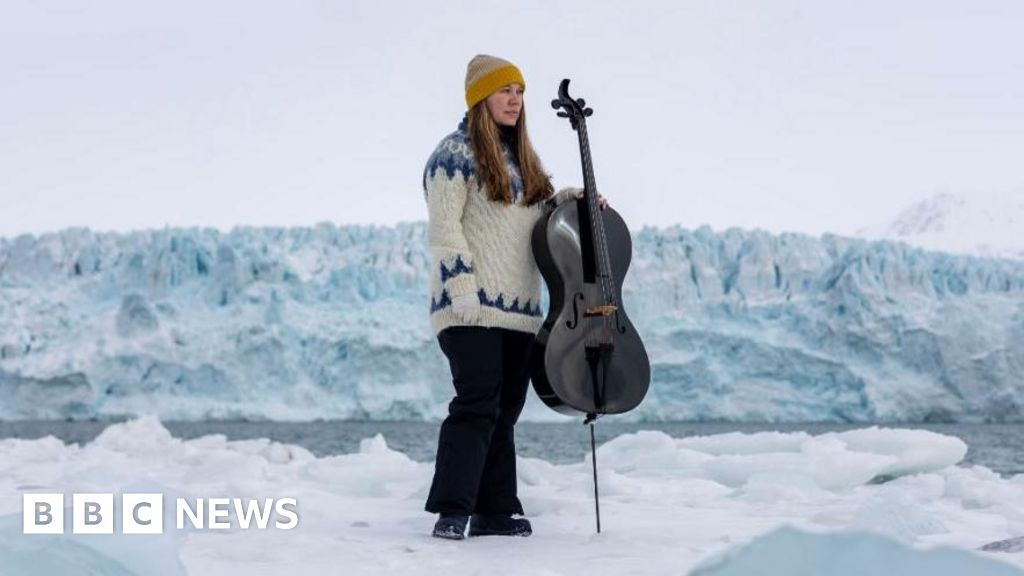When Nathan Simms moved into his dry cabin, it was level. But the ground is now giving way beneath his feet. “Slowly but surely one side of the cabin is sinking because the permafrost is thawing out,” Simms said, using his hands to emphasize the tilt. “So now you have the house on a lean, the door frame is getting harder to close, and the steps that go to the house are shifting and falling over too.”
Simms is far from the first to experience the effect that thawing permafrost can have on homes and buildings in the Interior. Even the building where Simms works — at UAF’s Institute of Agriculture — has wrestled with a permafrost-induced pit behind the parking lot for years. “A lot of the houses that were built 30 or 40 years ago were not built with long term changes like this in mind,” Simms said. “So they’re sinking.”
Many residents of Fairbanks have noticed these kinds of changes, including Terry Chapin. Chapin is a professor emeritus from the University of Alaska Fairbanks, who moved to Fairbanks with his family in 1973.
“I’m really concerned about the future that my family and especially my grandchildren are facing,” Chapin said. “Those people who have lived in Fairbanks for a long time have certainly noticed the changes between conditions now and what they were 20 years ago. Winter roads are much more icy. We have winter rains. There’s thawing permafrost that destabilizes both roads and buildings.”
In order to deal with the impacts of a changing climate, the Fairbanks North Star Borough created and adopted the “Climate Action and Adaptation Plan” or CAAP. But for most residents, what exactly the plan entails is poorly understood.
“Honestly, I just know that it exists,” said one resident who has lived in Fairbanks for 18 years. “That, and it’s often a topic of Borough Assembly meetings.”
Road to the CAAP
The road to the borough’s Climate Action and Adaptation Plan began long before it was passed. Back in the 1990s, Gov. Steve Cowper signed a resolution to develop a state climate change response plan. The Fairbanks North Star Borough didn’t join the state effort until 2007. That’s when the FNSB Assembly unanimously passed a resolution to gauge local climate change impacts and help the borough adapt to those impacts. They set five milestones, the first two of which — assessing climate vulnerability in the borough, and setting and prioritizing goals — they achieved by 2011.
There was a lull until 2019, when a group of University of Alaska Fairbanks students submitted suggestions to the Assembly for what a local climate action plan could look like. It was based on the Anchorage Climate Action Plan, which was adopted that same year. This, alongside vocal support from the Fairbanks Climate Action Coalition and the wider community, kickstarted renewed interest. In 2021, the borough Assembly created the Assembly Climate Action Committee to fulfill the milestones left from 2007 and develop a climate action plan for the borough.
Several versions of the Climate Action and Adaptation Plan were created. The first version had a greater emphasis on reducing the greenhouse gas emissions that cause climate change. However, priorities shifted after the first committee was dismissed by a reelected Assembly and replaced with new members. The second committee was more concerned about the cost of the CAAP to taxpayers and the risk of government overreach. They revised the plan and submitted it to the Assembly in June of 2023. But no one was satisfied. The public protested against it, arguing it had been watered down or was unnecessary. In the Assembly, it was unanimously defeated.
Terry Chapin had been involved in the borough’s climate efforts since 2007 and was in both iterations of the CAAP committee. He wasn’t about to let CAAP — the result of over a decade of hard work by the committee members, their predecessors, and local residents — go to waste. In fact, the two versions of the CAAP were not as different as many may have assumed.
“The second plan suggested many of the same action items as the first,” Chapin said. “It was just the motivations that were different. Rather than reducing Fairbanks’ impact on climate, it was about reducing energy costs.”
“If you can accept both those motivations — reducing costs and preventing climate change — you get a set of broadly agreed upon actions,” Chapin explained. “Recognize that some people will be motivated by cost and other people will be motivated by human impact on climate. So why not make both of these motivations equally acceptable and find something that can work for a broader spectrum of residents.”
This is what Chapin did with the third version of the Climate Action and Adaptation Plan. Chapin combined the two previous versions, emphasizing their overlap and synergy. On June 28, 2024, Chapin’s edited version of the CAAP was submitted to the Assembly as Resolution No. 2024-23. It passed. The Climate Action and Adaptation Plan is now part of the Fairbanks North Star Borough’s guiding documents. It can be read on the borough’s website by searching “Resolution No. 2024-23.”
A Plan in action
“A keyword for us is resiliency,” said Kuba Grzeda, the chief of staff for the borough mayor’s office. “The plan is a plan to build resiliency. That means being more prepared for rain in the winter, for dry summers, for increasing energy costs and trying to fight against that.”
The CAAP focuses on making borough operations more economical, sustainable and resilient in the face of climate change, ensuring the FNSB can prepare and adapt. The borough has a number of existing planning efforts similar to the CAAP, including the Hazard Mitigation Plan and Community Wildfire Protection Plan, which both include recommendations and strategies to reduce the impact of wildfire.
“It’s really important that there is overlap between these plans,” Chapin said. “The main gap the Climate Action and Adaptation Plan fills is helping people recognize that just because things were a particular way 20 or 50 years ago, doesn’t mean it’s gonna stay that way forever. It helps us plan for a future that’s changing.”
The existence of these plans also impacts the borough’s ability to get external funding opportunities. For example, a Hazard Mitigation Plan is required to get any funding from FEMA. As for the Climate Action and Adaptation Plan, it enables the borough to get climate-response funding. If the borough wants to add improved de-icing and traction to their transit buses, or even switch to electric-powered vehicles, the CAAP enables a funding agency to give them financial assistance.
One key point is that a plan is not a policy. The FNSB Climate Action and Adaptation Plan is, like other borough plans, a guiding document. It does not prescribe any mandates, and does not — and cannot — raise taxes. It’s more akin to a statement of values. When the time comes to renovate or replace borough facilities, like the Noel Wien Library, the borough will focus on renovations that align with goals in the plan, like improving energy efficiency.
“This plan doesn’t use words like ‘must,’ or ‘none,’ or ‘require.’ This plan uses words like ‘encourage,’ ‘create,’ ‘advise,’” said Assembly member Mindy O’Neall when she introduced the measure with the revised plan.
The biggest section of the Climate Action and Adaptation Plan is devoted to recommendations for action. Here, the CAAP lists its goals — and strategies to achieve these goals — across eight sectors, which range from agriculture to transit to health to waste management. Each sector has goals focused on making borough operations, such as managing the landfill, more cost effective and better prepared for a changing climate. The CAAP also details the FNSB’s powers, and how it can leverage those powers to serve residents without overstepping its legal bounds.
“There’s a lot that each department already does that is in the plan,” Grzeda said. “A lot of it pencils down to efforts that really pan out from a financial sense and then translate into climate aware and energy efficiency best practices.”
For example, in the section devoted to “Buildings and Energy,” there is a goal to promote energy savings for residents and businesses. To do so, the CAAP suggests improving design standards, energy efficiency, and funding for renewable energy. These efforts improve community health and the economy by reducing the energy costs, and making use of technologies like solar panels that reduce air pollution.
In the section devoted to “Food and Agriculture,” the CAAP encourages increasing food security and access to locally grown food as well as developing sustainable agriculture on borough lands. “Waste Management” suggests improving the borough recycling program and implementing community-wide composting. “Transit and Mobility” outlines reducing transportation energy costs, improving bicycle access, and reducing the vulnerability of roads to things like frost heaves or flooding.
Moving the plan
forward
This last goal is particularly relevant. For those like Chapin who have lived in Fairbanks for decades, the last few winters rank among the weirdest, thanks to repeated midwinter rain events. The winter of 2024 was already off to a poor start when the first snow of October was little more than frozen sleet. Repeated rain events in January and February made driving conditions particularly hazardous, covering roads in slick ice and closing schools for several days.
The CAAP encourages the development of design and maintenance strategies to handle the inevitable future winter icing events. This type of planning ensures that roads can better withstand the once-unusual conditions so less repair is needed, saving time and construction costs.
“The next really important step is the implementation of the plan, because if it just sits on a shelf it’s not gonna do any good,” Chapin said.
One of the most pressing questions is how the borough will finance its implementation of the plan. Many of the CAAP’s suggested strategies are inexpensive and slot neatly into pre-existing programs. But other suggested efforts, like installing solar panels on borough buildings, would have a high upfront price, even if they result in long term benefits and lower long-term costs.
The CAAP was written following the passing of the federal Bipartisan Infrastructure Law in 2021, which created an array of funding opportunities. But with its recent suspension, it and other federal funds are currently unavailable. This doesn’t mean the CAAP is to be consigned to the shelf, however.
“We’re facing a lot of different budgetary challenges across the borough,” noted Grzeda. “With all these challenges, I think the items that we’re going to end up starting with are the ones that have the largest bang for their buck.”
And some of it may not need to happen through the borough. For example, the private company Renewable Energy Systems wants to continue to move forward with their plans to develop wind farms near Fairbanks and Anchorage. They are currently working with GVEA to develop a purchase agreement that would give them financial security.
Following the election last fall, the new borough administration is working on getting the ball rolling to implement the CAAP in borough operations. It’s collaborating with the Fairbanks Climate Action Coalition to do so. One part will be to hire a program coordinator, who will work to tie together efforts across various borough departments, action plans, and programs.
“There’s a lot there, a lot to get excited about,” said Grzeda. “This is a document to help us get ready for the future and make smart investments along the way.”







 English (US) ·
English (US) ·